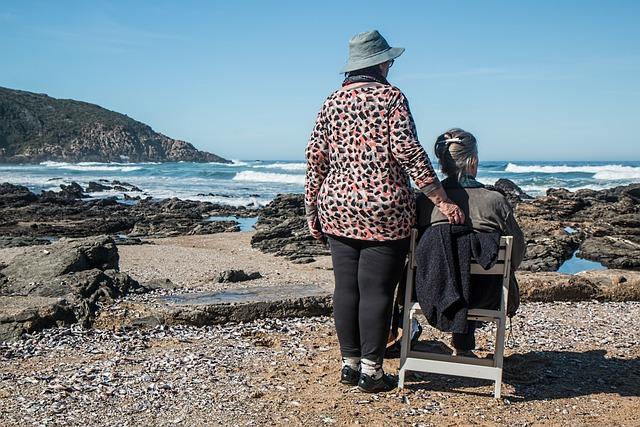Chair stretching exercises for seniors can help maintain their physical condition, presenting an approachable fitness routine that considers physical limitations. This form of exercise is not only easily adaptable but also focuses on minimizing the risk of falls, a primary concern for the elderly population.
Table of Contents
The 10 Best Chair Stretching Exercises for Seniors
Overhead Stretch
Begin seated, back straight and feet flat on the floor. Slowly lift your arms above your head, interlocking your fingers with palms facing upward. Stretch upwards as far as you are comfortable, hold for a few seconds, then gently lower your arms.
Upper Back Stretch
Extend your arms in front of you at shoulder height. Interlock your fingers with your palms facing outwards. Push your arms forward, curving your back gently and hold this position to stretch your upper back.
Chest Stretch
With your feet flat on the floor, stretch your arms out to your sides, palms facing forward. Gently pull your shoulders back and hold the position to stretch your chest.
Side Stretch
Raise one arm overhead, bending at the elbow so your hand drops down your back. Gently lean towards the opposite side until you feel a stretch. Hold this position, then repeat on the other side.
Deeper Side Stretch
Keeping your spine straight, extend one arm overhead and gently bend to the side, reaching with your hand. You should feel a stretch on the side of your body. Repeat with the other arm.
Spine Twist
Sit upright with your feet flat on the floor. Slowly turn your torso to one side, using the chair’s back for support. Hold this position to feel a stretch in your spine, then repeat on the other side.
Back of Thigh Stretch
Extend one leg in front of you, keeping the other foot flat on the floor. Gently lean forward from your hips until you feel a stretch in the back of your extended thigh. Hold this position, then repeat with the other leg.
Ankle Circles
Lift one foot off the floor, stretching your leg out in front of you. Slowly rotate your foot, making circles in the air. Rotate both clockwise and counter-clockwise before repeating with the other foot.
Shoulder Rolls
Raise your shoulders toward your ears, then roll them backward in a circular motion, repeating several times. Then, reverse the motion, rolling your shoulders forward.
Head Circles
Sit upright with your feet flat on the floor. Slowly rotate your head in a circle, first in one direction, then in the other. This exercise should be done slowly and carefully to avoid dizziness.
Importance of Chair Exercises
The essence of chair exercises lies in their potential to confer numerous health benefits. Notably, the process of stretching eases joint pain and muscle aches, and it also bolsters mobility, flexibility, coordination, and circulation. Beyond the realm of the physical, stretching also serves as a mood booster, helping reduce stress levels. It is, therefore, no wonder that chair exercises are gaining increased recognition for their utility among seniors.
Execution of the Exercise Routine
To start the routine, one needs to assume a seated position on a sturdy, non-slip chair. The emphasis lies in maintaining a good posture. However, it’s essential to acknowledge that not everyone might be able to achieve the ideal sitting position due to factors like physical conditions, past surgeries, or injuries. The key is to keep the body aligned and comfortable to avert any potential for pain or injury.
The series of stretches incorporated in this routine includes an overhead stretch, upper back stretch, chest stretch, and side stretch. There are more advanced exercises such as the deeper side stretch, spine twist, back of thigh stretch, and ankle circles. Finally, the series concludes with shoulder rolls, head circles, and another overhead stretch.
Safety and Comfort: A Priority
In executing these exercises, the foremost priority should always be safety and comfort. Participants should take care to follow the movements demonstrated by the instructor only to the extent that they are comfortable. None of the movements should inflict pain or discomfort, and individuals are free to modify or skip certain stretches based on their range of motion.
However, even with skipped exercises or limited ability, participants will still extract benefits from the routine. Chair exercises are versatile, and they continue to be beneficial irrespective of how many or how few are performed.
Progress over Time
The beauty of chair exercises lies in their progressive nature. Regular practice invariably leads to improvements in flexibility and strength over time. Older adults should remember to move gently and slowly, paying close attention to their bodies to avoid any risk of injury.
It’s vital to understand that improvement may not be instantaneous. Progress might seem slow, and that is entirely normal. The focus should be on consistent practice and gradual progress. Over time, the benefits will be unmistakable in the form of improved physical health and a boosted mood.
Conclusion
Chair stretching exercises offer seniors a practical solution for maintaining physical fitness. The routines are easy to adapt, considerate of physical limitations, and focus on safety and comfort above all. They allow seniors to keep active, boost their moods, and improve physical strength and flexibility without putting themselves at risk.

